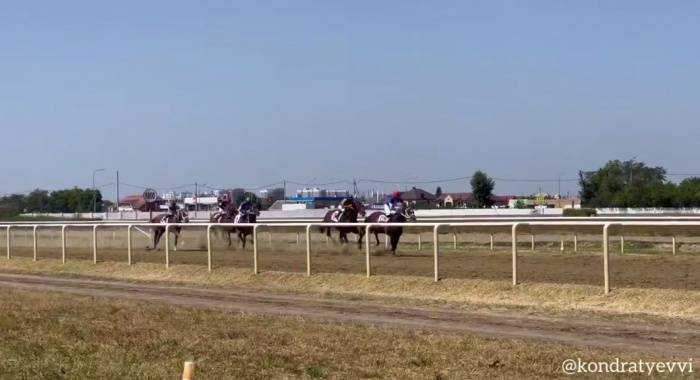The Governor’s Cup of Kuban took place at the Krasnodar Hippodrome. The competitions were observed by the head of the region, the chairman of the Legislative Assembly, and vice-governors. The total prize fund for the race day amounted to 16 million 950 thousand rubles.
“Horse breeding is an important part of the history and culture of the Krasnodar region. For a Cossack, a horse has always been a faithful friend, a combat companion, and a helper in labor. It is no coincidence that our ancestors said: ‘To a Cossack, the horse is dearer than himself.’ It is important that the Cossack equestrian traditions, love, and sincere attachment to racehorses have been preserved to this day and have become part of modern life. And we will do everything to pass this heritage on to our children and grandchildren. Because we want future generations to know their roots, to grow up as people who are just as strong in spirit and will,” he said.
Over 10 years, more than 460 million rubles have been directed to this branch of animal husbandry in the region. In 2025, 97.5 million rubles were allocated for testing pedigree horses. The governor noted that the Krasnodar region will continue to maximally promote the development of horse breeding.
11 races featured horses of thoroughbred breeds—English, Akhal-Teke, and Arabian. Jockeys covered distances from 1 to 2.4 kilometers.
The largest prize of 5 million rubles was contested in the races for the Governor’s Cup of the Krasnodar region. The winner was awarded personally. The winning pair was jockey Andrey Kirshin and the stallion named Albertini Bars from the Pavlovsky district.
In addition to this award, two more from the head of the region—”Beauty of Kuban” and “Hope of Kuban”—were contested, as well as the prize of the Legislative Assembly. It was won by jockey Aitbek uulu Baish on the dark bay stallion named Imperial Mo. Also during the race day, competitions were held for the prizes of the Ataman of the Kuban Cossack Host, the grain growers and horse breeders of Kuban, in memory of Nikolay Kondratenko, and others.
Spectators of the races participated in a hat contest and master classes, and famous creative groups of the region performed for them. Horseback riding was organized for children.
Krasnodar Hippodrome
The Krasnodar Hippodrome is a historic horse racing venue in southern Russia, established in the late 19th century. It has long served as a major center for equestrian sports, breeding, and testing of thoroughbred horses in the Kuban region.
Governor’s Cup of Kuban
The Governor’s Cup of Kuban is a major annual horse racing event held in the Krasnodar Krai region of Russia. It was established to celebrate and promote the region’s strong traditions in horse breeding, particularly for thoroughbreds. The prestigious race serves as a highlight of the local sporting and cultural calendar.
Krasnodar region
The Krasnodar region, historically known as Kuban, is a federal subject in Southern Russia, famed for its fertile black soil and agricultural production. Its history is deeply tied to the Cossacks, to whom the land was granted by Catherine the Great in the late 18th century following Russia’s expansion into the territory. Today, it is a major economic and tourist hub, home to the popular resorts of the Black Sea coast like Sochi.
Cossack equestrian traditions
Cossack equestrian traditions are a historic martial art and cultural practice originating from the warrior communities of Eastern Europe and Southern Russia. These traditions, which date back to the 15th century, are famed for their spectacular displays of horsemanship, including daring tricks, acrobatics, and expert cavalry skills. They remain a powerful symbol of Cossack identity, courage, and freedom.
English thoroughbred horses
English thoroughbred horses are a distinguished horse breed developed in 17th- and 18th-century England, primarily for the purpose of horse racing. They originated from the crossbreeding of native mares with imported Oriental stallions, such as the Godolphin Arabian, the Byerley Turk, and the Darley Arabian, whose bloodlines form the foundation of the breed. Today, they are celebrated worldwide as premier racehorses, renowned for their speed, agility, and spirit.
Akhal-Teke horses
The Akhal-Teke is an ancient and distinctive horse breed from Turkmenistan, renowned for its metallic sheen and incredible endurance. Historically bred by the Teke tribe, these horses were developed for speed and stamina to survive the harsh conditions of the Karakum Desert. They are a national point of pride and a cherished cultural symbol of Turkmenistan.
Arabian horses
Arabian horses are not a place or cultural site, but a historic and culturally significant breed of horse originating from the Arabian Peninsula. They are one of the world’s oldest horse breeds, with a history tracing back thousands of years and were historically bred by the Bedouin people for their endurance in the desert. Their distinctive head shape and high tail carriage have made them one of the most recognizable and influential horse breeds globally.
Kuban Cossack Host
The Kuban Cossack Host was a Cossack military formation in the North Caucasus region of Russia, established by Catherine the Great in the late 18th century. Primarily composed of re-settled Zaporozhian Cossacks, they were tasked with defending the empire’s southern borders and played a major role in the colonization of the Kuban region.






